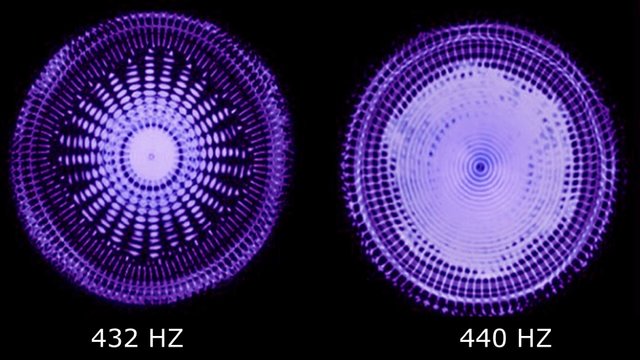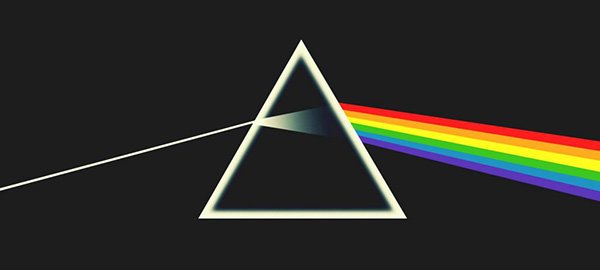The sound and frequency at 432Hz and 440Hz / Il suono e la frequenza a 432Hz e 440Hz
The sound and frequency at 432Hz and 440Hz
Hello Steemians and well received friends.
Today we treat the tuning of the instruments, more specifically we enter a little into the scientific and we analyze the frequencies of the sound between the standard tuning imposed at the global level (440Hz) and the golden tuning (432Hz) or natural.
Let's start by saying that the sound is formed by waves that have a certain frequency; so called because it is a phenomenon that presents a trend consisting of events that over time are repeated identical or almost and that are the result of the number of events that are repeated in a given unit of time. Its unit of measure is Hertz (Hz).
A characteristic of sound, in terms of its height, is the intonation, fundamental in music, which is based on the difference between an emitted sound and a reference sound. This phase is essential when a musical instrument is tuned: when both sounds are on the same frequency, the instrument is tuned; if, on the other hand, the sound emitted with respect to the reference sound is decreasing or therefore increasing with a different frequency, we will speak of a false instrument.
In the universally recognized standard music system, the note LA in central octave (A3 for instruments tuned in LA) corresponds to 440 Hz.
Virtually all the music we hear today, with rare experimental exceptions, is based on this pitch frequency.
But who established that the 440Hz should be the standard of tuning? Well here we enter in different hypotheses but the most credited seems to be the following:
In 1939, just before the outbreak of the Second World War, the Berlin Radio Acoustics Commission organized a congress in London at the British Standard Association to internationally adopt the 440 Hz tuning of the German radio. A congress to which neither the Italian composers nor the French composers were invited. This decision was promoted and carried out by Joseph Goebbels, Nazi propaganda minister, who proclaimed the new intonation as a German officer. It is also said that Hitler, a great admirer of Wagner who composed music in 440Hz, wanted to impose that frequency obligatorily for music.
In the 70s this measure became standard almost everywhere, despite the countless musician protests and a referendum asking to stay at 432Hz.
After the war and defeated the Nazis, in 1953 a second congress was organized in London which remained, however, firm in the decision to adopt standardization on the 440 Hz value. A decision taken, once again, in total lack of transparency. The latter element has left to suppose that beyond the "Nazi conspiracy" there was something more behind this choice.
The Paris conservatory professor Robert Dussaut stated that English luthiers were driven by commercial interests linked to selling instruments to American jazz musicians, who were already performing by tuning their instruments to 440 Hz.

Giuseppe Verdi had realized that the 432Hz tuning certainly had something different, and he pointed out how wrong it was to raise the pitch, especially coming around 450Hz. One of his letters on the subject is still preserved in the Milan Conservatory:
"Since the normal tuning fork (435 Hz) was adopted in France, I advised that the example be followed by us too; and I formally asked the orchestras of different cities of Italy, among others that of La Scala, to lower the chorister (diapason) conforming to the normal French. If the Musical Commission established by our Government believes, for mathematical reasons, to reduce the 435 vibrations of the French chorister to 432, the difference is so small, almost imperceptible to the ear, that I willingly adhere to it. It would be a serious, very serious error to adopt a 450-vibration tuning fork from Rome. I am of the opinion that the lowering of the chorister does not detract from the sound and verve of the performance; but on the contrary it gives something more noble, more full and majestic that they could not give the screams of a too sharp chorister. For my part, I would like a single chorister to be adopted throughout the musical world. The musical language is universal: why should the note named LA in Paris or Milan become a B flat in Rome? "
It has been scientifically proven that sound frequencies are incredibly incident on our body, both physically and mentally and can have both beneficial and negative effects. Just think of the Mozart Therapy. There are frequencies that can make us feel more relaxed, which help to cure us from depression and bad mood, others that are even useful for coping with toothache and other diseases, even quite serious ones. Other frequencies, on the other hand, can cause negative effects and be a control tool. The 432 Hz tuning is called golden or natural tuning precisely because it refers to the golden proportion, a numerical scale that is at the base of the whole nature. It is intonation closer to the natural one of the human voice, it has more harmonics and for this it has different beneficial effects, such as relaxation, the regulation of breathing and heartbeat, the cure of some diseases. The harmonics also exist in their multiples and sub-multiples and 432 is a multiple of 8. The frequencies of 8 Hz (and relative proportions) are present in nature in many contexts, for example DNA replication, the Earth's rotary motion ( Schumann frequency) Often we talk about the beauty of 528 Hz, frequency very similar to 432Hz.
It is difficult and sad to think that music, which essentially makes us feel so good, is actually influenced by such negative factors. The intonation at 440 Hz, to which we are now addicted, is instead practically unnatural, creates disharmony difficult to perceive by humans, has few harmonics and is evidently not chosen randomly as a standard intonation. It was institutionalized by the Rockefeller Foundation, discovered by German military intelligence and used during the Holocaust, also to spur the most arduous work in concentration camps. Attempts to return to La Verdi (432Hz) inevitably failed. The difference between the two frequencies is also found at the physical level. It is enough to observe the forms that are created during a cymatic experiment, understanding that the waves at 432Hz are decidedly more harmonic. Fortunately there are still artists who make up their music with a 432Hz pitch. Among these we cannot fail to mention Pink Floyd which, especially in The Dark Side Of The Moon, can give us a striking example of the difference between the various frequencies.
The 432Hz make up what is called Love frequency and that is part of what lies at the base of nature, of the universe, of the philosophy pursued by various scholars (including Plato). It is connected to the heart chakra, that of feeling and of the Earth, while the 440 Hz are reconnected to the chakra that deals with brain control.
Below, a video on Youtube for experiment in 432Hz and 440Hz.

Il suono e la frequenza a 432Hz e 440Hz
Buongiorno amici Steemians e ben ritrovati.
Oggi trattiamo l'accordatura degli strumenti, più specificatamente entriamo un po' nello scientifico ed andiamo ad analizzare le frequenze del suono tra l'accordatura standard imposta a livello globale (440Hz) e l'accordatura aurea (432Hz) o naturale.
Iniziamo col dire che il suono è formato da onde che hanno una certa frequenza; così chiamata perchè è un fenomeno che presenta un andamento costituito da eventi che nel tempo si ripetono identici o quasi e che sono il risultato del numero degli eventi che vengono ripetuti in una data unità di tempo. La sua unità di misura è l' Hertz (Hz).
Una caratteristica del suono, in ordine alla sua altezza, è l’intonazione, fondamentale nella musica, che si basa sulla differenza tra un suono emesso ed un suono di riferimento. Questa fase è fondamentale quando viene accordato uno strumento musicale: quando entrambi i suoni si trovano sulla stessa frequenza, lo strumento è accordato; se invece il suono emesso rispetto a quello di riferimento è calante o crescente quindi di frequenza diversa, si parlerà di strumento stonato.
Nel sistema musicale standard universalmente riconosciuto, la nota LA in ottava centrale (A3 per gli strumenti accordati in LA) corrisponde a 440 Hz.
Praticamente tutta la musica che ascoltiamo oggi, salvo rare eccezioni sperimentali, si basa su questa frequenza di intonazione.
Ma chi ha stabilito che i 440Hz devono essere lo standard dell'accordatura? Beh qui entriamo in diverse ipotesi ma la più accreditata pare sia la seguente:
Nel 1939, poco prima dello scoppio della Seconda Guerra Mondiale, la Commissione Acustica della Radio di Berlino organizzò un congresso a Londra presso la British Standard Association per adottare internazionalmente l’intonazione a 440 Hz della radio tedesca. Congresso a cui non furono invitati nè i compositori italiani, nè quelli francesi. Questa decisione fu promossa e portata avanti da Joseph Goebbels, ministro della propaganda nazista, che proclamò la nuova intonazione come ufficiale germanica. Si dice anche che Hitler, gran estimatore di Wagner che componeva musiche in 440Hz, volle imporre quella frequenza obbligatoriamente per la musica.
Negli anni '70 questa misura divenne standard praticamente ovunque, nonostante le innumerevoli proteste dei musicisti ed un referendum che chiedeva di rimanere a 432Hz.
Finita la guerra e sconfitto il nazismo, nel 1953 fu organizzato a Londra un secondo congresso che rimase, però, fermo nella decisione di adottare la standardizzazione sul valore dei 440 Hz. Una decisione presa, ancora una volta, in totale mancanza di trasparenza. Elemento quest’ultimo che ha lasciato supporre che oltre il “complotto nazista” ci fosse qualcosa in più dietro questa scelta.
Il professore del conservatorio di Parigi Robert Dussaut dichiarò che i liutai inglesi erano spinti da interessi commerciali legati alla vendita di strumenti ai jazzisti americani, che già si esibivano accordando i loro strumenti a 440 Hz.

Giuseppe Verdi aveva intuito che l’accordatura a 432Hz aveva certamente qualcosa di diverso, e precisò quanto fosse errato innalzare l’intonazione, specialmente arrivando intorno ai 450Hz. Una sua lettera in proposito è ancora conservata nel Conservatorio di Milano:
“Fin da quando venne adottato in Francia il diapason normale (435 Hz) , io consigliai venisse seguito l’esempio anche da noi; e domandai formalmente alle orchestre di diverse città d’Italia, fra le altre quella della Scala, di abbassare il corista (diapason) uniformandosi al normale francese. Se la Commissione musicale istituita dal nostro Governo crede, per esigenze matematiche, di ridurre le 435 vibrazioni del corista francese in 432, la differenza è così piccola, quasi impercettibile all’orecchio, ch’io aderisco di buon grado. Sarebbe grave, gravissimo errore, adottare come viene da Roma proposto un diapason di 450 vibrazioni. Sono d’opinione che l’abbassamento del corista non toglie nulla alla sonorità ed al brio dell’esecuzione; ma dà al contrario qualche cosa di più nobile, di più pieno e maestoso che non potrebbero dare gli strilli di un corista troppo acuto. Per parte mia vorrei che un solo corista venisse adottato in tutto il mondo musicale. La lingua musicale è universale: perché dunque la nota che ha nome LA a Parigi o a Milano dovrebbe diventare un SI bemolle a Roma?”
E' stato provato scientificamente che le frequenze sonore sono incredibilmente incidenti sul nostro corpo, sia a livello fisico che mentale e possono avere, sia effetti benefici che negativi. Ci basti pensare alla Terapia Mozart. Esistono frequenze che riescono a farci sentire più rilassati, che aiutano a curarci dalla depressione e dal malumore, altre che sono addirittura utili per far fronte al mal di denti e ad altre malattie anche abbastanza gravi. Altre frequenze, invece, possono causare effetti negativi e risultare come strumento di controllo. L’accordatura a 432 Hz è chiamata accordatura aurea o naturale proprio perché si rifà alla proporzione aurea, una scala numerica che si trova alla base dell’intera natura. È un’intonazione più vicina a quella naturale della voce umana, possiede più armoniche e per questo ha diversi effetti benefici, come il rilassamento, la regolazione del respiro e del battito del cuore, la cura di alcune malattie. Le armoniche, inoltre, esistono anche nei loro multipli e sottomultipli e 432 è un multiplo di 8. Le frequenze di 8 Hz (e relative proporzioni) sono presenti in natura in moltissimi contesti,ad esempio la replicazione del DNA, il moto rotatorio Terrestre (frequenza Schumann) Spesso si parla anche della bellezza dei 528 Hz, frequenza molto simile ai 432Hz.
Risulta difficile e triste pensare che la musica, che essenzialmente ci fa stare così bene, sia in realtà influenzata da fattori così negativi. L’intonazione a 440 Hz, alla quale siamo oramai assuefatti, è invece praticamente innaturale, crea disarmonie difficilmente percettibili dagli esseri umani, ha poche armoniche ed evidentemente non è stata scelta casualmente come intonazione standard. Fu istituzionalizzata dalla Rockefeller Foundation, scoperta dall’intelligenza militare tedesca e usata durante l’olocausto, anche per spronare al lavoro più arduo nei campi di concentramento. I tentativi di ritornare al La verdiano (432Hz) sono inevitabilmente falliti. La differenza tra le due frequenze si ritrova anche a livello fisico. Basta osservare le forme che si vengono a creare durante un esperimento di cimatica, comprendendo che le onde a 432Hz sono decisamente più armoniche. Fortunatamente esistono ancora degli artisti che compongono la loro musica con un’intonazione a 432Hz. Tra questi non possiamo non citare i Pink Floyd che, specialmente in The Dark Side Of The Moon, possono darci un esempio lampante della differenza tra le varie frequenze.
I 432Hz compongono quella che viene chiamata Love frequency e che fa parte di ciò che si trova alla base della natura, dell’universo, della filosofia portata avanti da diversi studiosi (tra cui Platone). È collegata al chakra del cuore, quello del sentimento e della Terra, mentre i 440 Hz vengono ricollegati al chakra che si occupa de controllo del cervello.
Qui sotto,nel link un video tratto da YouTube che mostra un esperimento di Cimatica sulle frequenze qui trattate.

Congratulations @hjmarseille! You have completed the following achievement on the Steem blockchain and have been rewarded with new badge(s) :
You can view your badges on your Steem Board and compare to others on the Steem Ranking
If you no longer want to receive notifications, reply to this comment with the word
STOPTo support your work, I also upvoted your post!
This post was selected, voted and shared by the discovery-it curation team in collaboration with the C-Squared Curation Collective. You can use the #Discovery-it tag to make your posts easy to find in the eyes of the curator. We also encourage you to vote @c-squared as a witness to support this project.
Hello,
Your post has been manually curated by a @stem.curate curator.
We are dedicated to supporting great content, like yours on the STEMGeeks tribe.
If you like what we are doing, please show your support as well by following our Steem Auto curation trail.
Please join us on discord.
Pazzesco non sapevo c'erano di mezzo anche qui i Rockfeller!!
Comunque scommetto che conosci Corrado Malanga, in caso non lo avessi mai sentito guardati su youtube le sue ultime conferenze XCongres 2019. Fra le tante cose parla anche di questo.
Grazie per il tuo commento. Beh, quella dei Rockfeller è una delle teorie, personalmente ritengo più plausibile quella dei tedeschi. Resta comunque valido il fattore scientifico degli esperimenti condotti in acqua e con polveri sulle frequenze emesse.
Il vero problema non è chi sia stato ma il perchè di tale scelta! Chissà cosa provoca realmente questa differenza se pur piccola di frequenza a livello psico-fisico?
Come minimo ha un effetto "sonnifero" per la coscienza, e per lo sviluppo delle capacità mentali, quali il ragionamento autonomo.
Tra l'altro la differenza è proprio di 8 Hz, non penso sia un caso, data l'importanza di tale frequenza.
Ciao e grazie a te per il post che hai fatto
Sicuramente una ragione c'è. Ti dico anche che da quando uso l'accordatura a 432 anzichè a 440, la mia chitarra è come se fosse rinata....suono morbido,pulito e ricco di armonici. Se anche uno come Giuseppe Verdi appoggiava il 432, ci sarà ben un motivo.
Grande, bravo fai benissimo.
Io invece non lo uso per niente l'accordatore (quando suono a casa), la tengo come più mi garba :)
Molto bello e interessante, da approfondire sicuramente. Ottimo lavoro
Un saluto, nicola
Grazie, magari in futuro riprendo la cosa.
Wow, amazing!
Resteem!
Thanks
Thanks!
This post has been voted on by the SteemSTEM curation team and voting trail. It is elligible for support from @curie and @minnowbooster.
If you appreciate the work we are doing, then consider supporting our witness @stem.witness. Additional witness support to the curie witness would be appreciated as well.
For additional information please join us on the SteemSTEM discord and to get to know the rest of the community!
Please consider using the steemstem.io app and/or including @steemstem in the list of beneficiaries of this post. This could yield a stronger support from SteemSTEM.
i do music on 432 hz to chakra alignment, thank you for the spreading of this information.
Thanks!
informazioni preziose che stai dando!!!